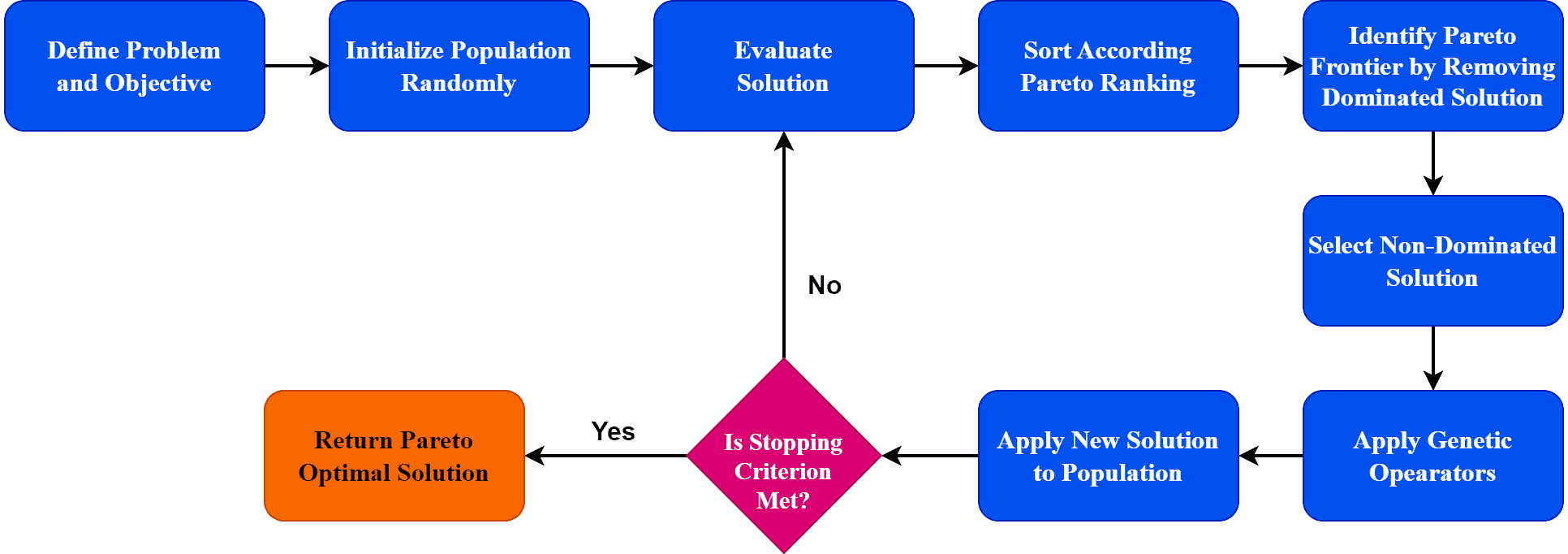1. 概述
在本教程中,我们将通过实际例子来讲解多目标算法(Multiobjective Algorithms)与帕累托前沿(Pareto Frontiers)。我们会介绍多目标算法的一般步骤,并阐述帕累托前沿的重要性。
最后,我们还会探讨多目标算法的一些优缺点,帮助你更好地理解其应用场景与局限性。
2. 多目标算法
多目标算法是一类优化技术,用于在多个目标之间寻找最优解。 这类算法广泛应用于工程、机器人、设计、公共政策等多个领域。
多目标算法适用于需要权衡与优先级排序的复杂问题。这类问题通常没有单一最优解,而是存在一组解,每个解在不同目标下表现各异。
举个例子:一家公司希望在最小化成本的同时最大化利润的前提下,确定多种产品的最优生产水平。此时,决策变量是每种产品的生产量,目标函数是总成本和总利润,而约束条件可能包括产能限制和市场需求。
常见的多目标算法包括:
- 遗传算法(Genetic Algorithms)
- 粒子群优化(Particle Swarm Optimization, PSO)
- 模拟退火(Simulated Annealing)
- 禁忌搜索(Tabu Search)
- 进化算法(Evolutionary Algorithms)
✅ 踩坑提醒:选择算法时要注意问题的维度和约束条件,否则容易陷入计算瓶颈或收敛困难。
3. 帕累托前沿(Pareto Frontiers)
帕累托前沿是一组非支配解(non-dominated solutions)的集合,代表了多个目标之间的最佳权衡。 它的名字来源于帕累托法则(80-20 原则),即少数因素决定了大部分结果。
在多目标优化中,一个解如果在某个目标上更优而不损害其他目标,则它优于另一个解。这种关系称为“支配(dominance)”。一个解如果不被其他任何解支配,那么它就位于帕累托前沿上。
举个例子:一家公司希望在产品设计中同时最小化制造成本和最大化性能。决策变量包括材料选择、制造工艺等;目标函数是成本和性能;约束条件包括制造能力与市场需求。
帕累托前沿将展示出一系列设计方案,这些方案在成本与性能之间达到了最佳平衡。任何在帕累托前沿上的设计都无法在不增加成本的前提下提升性能,也无法在不降低性能的前提下降低成本。
4. 多目标算法的工作流程
多目标算法的一般流程如下图所示:

定义问题与目标
明确决策变量、约束条件和目标函数,确保目标可量化。初始化种群
随机生成一组初始解,种群大小取决于问题复杂度。评估解的质量
根据目标函数对每个解进行评估,这一步通常计算量较大。帕累托排序(Pareto Ranking)
对解进行非支配排序,找出当前种群中的帕累托前沿。选择与进化
使用交叉(Crossover)和变异(Mutation)等遗传操作生成新解。更新种群并判断是否终止
将新解加入种群,判断是否满足停止条件(如迭代次数、收敛性等)。若未满足,返回步骤 3。
⚠️ 注意:评估过程可能非常耗时,建议采用高效评估机制或并行处理。
5. 多目标算法的优缺点
✅ 优点
- 适用于多目标权衡场景:帮助理解不同目标之间的相互影响。
- 提供多个非支配解:让决策者根据实际需求选择最优解。
- 广泛适用性:可用于工程、设计、政策等多个领域。
- 处理复杂问题能力强:适合高维、多变量、多约束问题。
- 对噪声具有一定鲁棒性:更适合真实世界的不完美数据。
❌ 缺点
- 实现复杂:算法设计和调参难度较高。
- 计算开销大:尤其在高维问题中,易出现“维度灾难”。
- 可视化困难:超过两个目标时,帕累托前沿难以直观呈现。
- 权衡过程主观:最终选择仍依赖于决策者的偏好。
6. 总结
本文我们介绍了多目标算法的基本概念、工作流程以及帕累托前沿的核心作用。通过实际例子说明了多目标优化在实际问题中的应用方式,并分析了其优缺点。
如果你正在处理多个目标之间存在冲突的问题,多目标算法是一个非常值得尝试的工具。但也要注意其计算复杂性和实现难度,合理选择算法并做好调参工作。